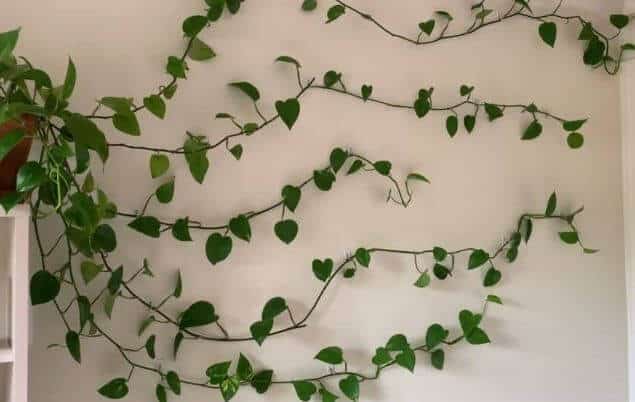Last Updated on January 5, 2023 by a Friendly Gardener
The Pothos is a wonderful vining houseplant that can adapt to any number of environments including low-light spaces. As a vining plant, the Pothos can either be a trailer or a climber. Commonly, many Pothos plants are cultivated in hanging baskets, but some plant parents may prefer to have their Pothos climb.
Botanically named Epipremnum Aureum, and popularly known as “devil’s ivy”, the Pothos is one of the easiest houseplants to grow. A native of tropical forests in Mexico, the Caribbean, and South America, it thrives inside homes, businesses, apartments, and offices, globally. Vibrant green heart-shaped leaves, often variegated, add color and decoration anywhere. The Pothos is an evergreen that thrives year-round with the proper care.
Does Pothos Climb?

In their native habitats, Pothos plants will naturally climb from the floor of the forest upward toward a light source. When included in indoor gardens they can follow their vining instinct if there is a light source above the plant. The Pothos can be trained to climb rafters, shelves, walls, trellises, and a variety of support structures.
How to Train Pothos Plant to Climb

Although it may seem somewhat of a challenge to train an indoor plant to climb, the Pothos is a great climbing plant because it does not need direct exposition to the sun. It thrives in multiple environmental conditions and temperatures, and it is a very low-maintenance plant for those that don’t have a lot of time for plant care.
To encourage climbing, follow these easy steps and your Pothos will be climbing in no time.
- For good results, look for a place that offers medium bright but indirect light if possible. Ideally, indoor humidity should be moderate, and the room temperature should measure between 70° and 75°F. These are optimal conditions for training your Pothos to climb.
- Choose a proper container for your Pothos with drainage holes. Choose a pot that is one to two inches larger than the root ball.
- Consider the growing medium you have planted your Pothos in. Opt for fertile, good-quality all-purpose potting soil that drains well. If you have any doubts, add a fist full of perlite to the soil.
- Select your preferred support structure. This can be a trellis, a pole, a wall, or another preferred type of structure. Make sure you have a method for tying or attaching your plants such as plant ties, wire, hooks, floral pins, string or garden twine, Velcro strips, or some kind of hanger and scissors or shears for cutting.
- If you are using a pole, trellis, or other, introduce the support structure into your plant’s pot and decide if you want the structure to be visible or not. Position it in such a way that the plant stems can reach the support and attach themselves. Trellises can, like poles, be placed in pots or they can lean against walls. They should be stable to support the plant’s weight as it grows. Lattices can be created in the desired shape using wood pieces or bamboo canes if you want a specific design.
- When you have positioned your support structure, gently train your Pothos to climb it by tying the vines to the selected structure using string, plant ties, or wire. Make sure that vines are securely attached but do not tie so tight that the stems suffer damage. If your Pothos is a larger plant, you can prune some stems to shorter lengths so that they are easier to train and attach. Never prune more than a third of the plant at one time.
- Feed your Pothos approximately once every three months particularly during the growing season to aid its development while climbing.
- As the Pothos grows, you may need to continue tying it, perhaps even adding to your support structure. You may also need to prune it to shape its climbing habit.
How to Train Pothos to Climb a Wall

To train a Pothos to climb a wall, you will still need support in place. You can either attach a trellis-like structure to a wall, or you can attach wire hangers, hooks, picture hangers, or similar to the wall and then attach your Pothos to these.
How Long Will a Pothos Need to Climb Successfully?
Much depends on the size of your plant when you begin training it. If the plant is just a cutting, you may need a couple of years for your plant to grow sufficiently for it to be trained. You can begin to train a cutting from the start, but some patience will be required as your plant will need time to grow. The speed of growth will depend on how much light is available, the water, and even the size of the plant’s container.
Can I Make My Pothos Grow Faster?

To encourage a faster rate of growth, select a location that has a consistent environmental temperature measuring between 70° and 90°F. The plant should receive a generous amount of indirect, bright sunlight, and the occasional feeding.
Generally speaking, the Pothos is not a slow grower, so with the right conditions, you should see results relatively quickly. Do take care not to overwater as the Pothos, like most houseplants, can develop root rot if left to sit in soggy soil.
Is a Pothos Better as a Hanging or Climbing Plant?
The Pothos that is well taken care of will thrive whether hanging or climbing. Climbers may develop larger foliage as they climb toward a light source. Hanging Pothos may develop smaller leaves if they have less access to light.
In a natural habitat, a Pothos can generally be found climbing and wrapping itself around tropical forest trees or other kinds of vegetation. It does this to receive sufficient indirect sunlight for photosynthesis which they need to do for nourishment.
Regardless of whether it hangs or climbs, you may need to untangle vines occasionally for appearance’s sake. You may also choose to prune away the aerial roots that the plant will develop if you opt for a hanging Pothos. The plant uses these aerial roots to attach itself to trees in its natural habitat.
Will a Climbing Pothos Damage My Wall?

Pothos vines naturally attach to surfaces along their path. Roots are thin and shallow so they should not harm wall surfaces. They may superficially dirty the wallpaper or paint especially if the plant is too moist. Observe your plant weekly and if you notice any signs of wall damage, you can train it in another direction or change its position.

